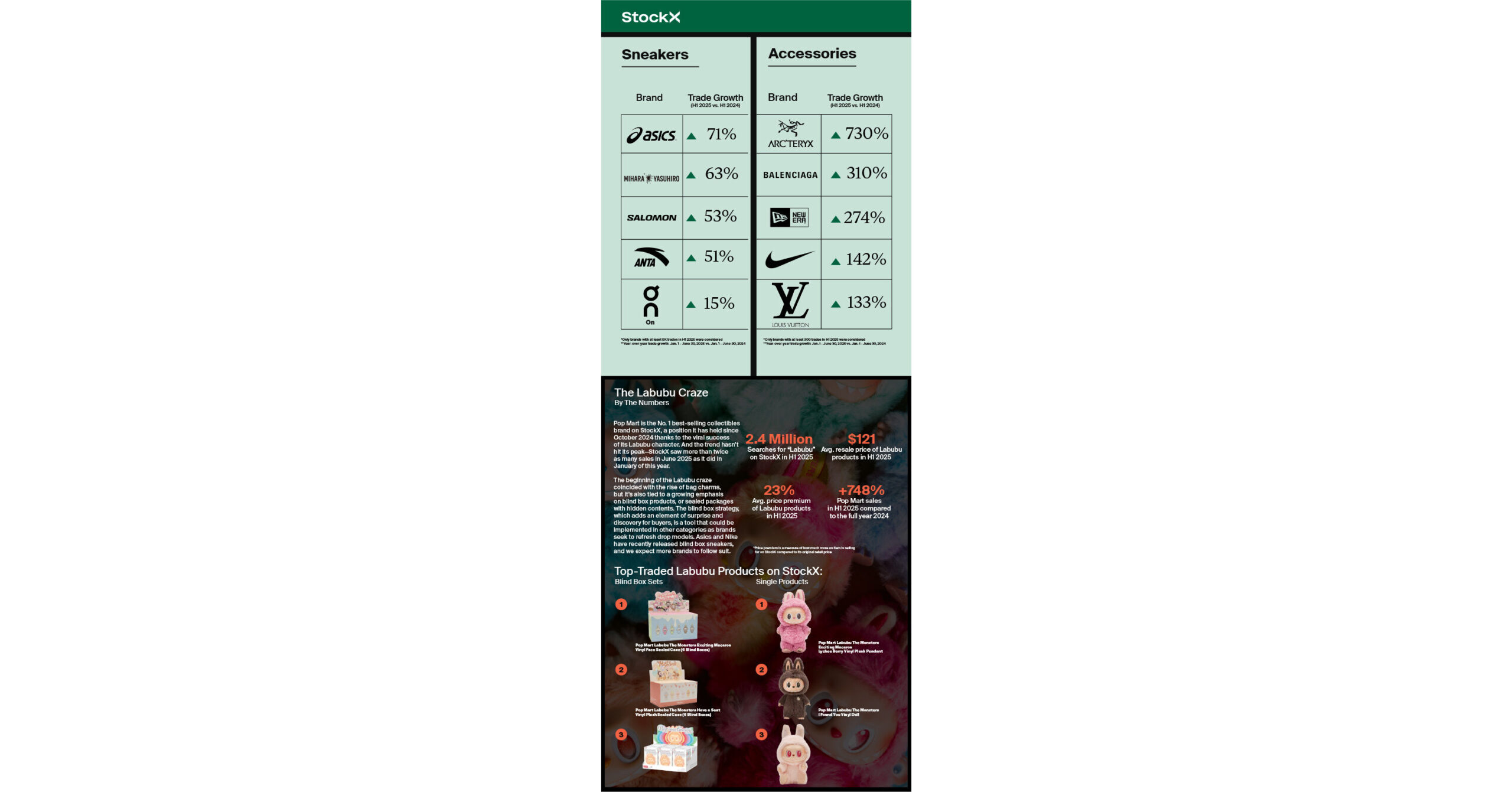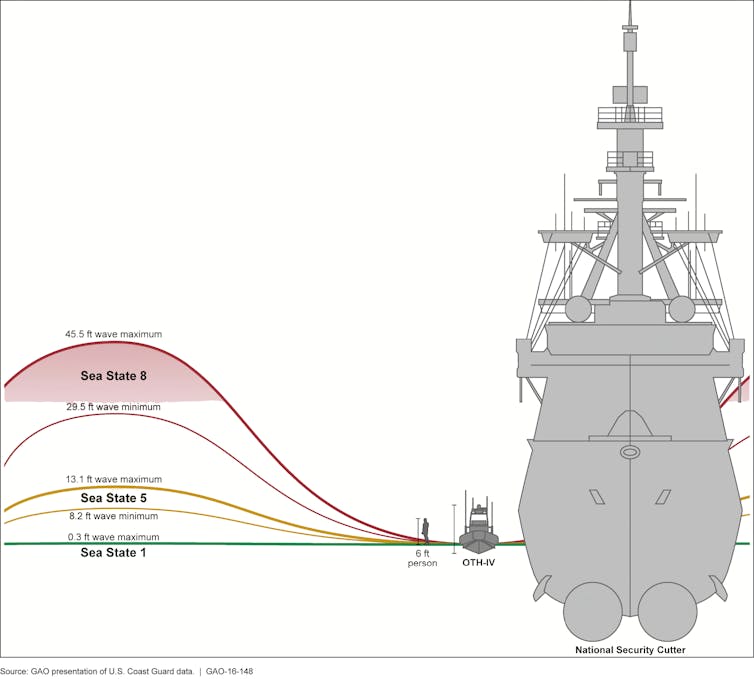Other brands seeing meaningful growth in 2025 include Louis Vuitton, New Era, Clarks, and Bravest Studios
DETROIT, Aug. 13, 2025 /PRNewswire/ — Today StockX dropped its latest midyear data report, Big Facts: Brands Making Moves, highlighting the fastest-growing brands across sneakers, collectibles, shoes, apparel, and accessories. Drawing on StockX’s global sales data from the first half of 2025 compared to the same period in 2024, the report reveals which brands are gaining momentum and market share among today’s culture-driven consumers. Notable takeaways include the continued dominance of performance styles in the sneaker space, a surge in interest in trading cards and Pop Mart’s Labubu collectibles, the enduring appeal of Murakami, and an increased focus on jerseys within the apparel space.
StockX’s latest midyear report highlights the fastest-growing brands across sneakers, collectibles, shoes, apparel, and accessories in 2025.
“This year’s report underscores how both old and new brands are winning over consumers and finding success on our platform,” said StockX CEO Greg Schwartz. “From the Labubu phenomenon to up-and-comers like Bravest Studios, there’s great energy in the secondary market right now. I’m excited by the growth we’re tracking and the number of consumers who continue to turn to StockX to make these purchases. Their passion fuels everything we do.”
Key Report Highlights:
- Asics maintained its No. 1 spot in the sneakers category, while Salomon returned to growth. Asics (+71%) is the fastest-growing sneaker brand on StockX for the second straight year. The Gel-1130 remains its top-selling silhouette and was a key growth driver, as was the Gel-NYC. A smaller boost came from the GT-2160, a silhouette that several big names put their mark on recently, including JJJJound, Kiko Kostadinov, and Kith. Salomon, meanwhile, enjoyed a comeback this year. It returned to the list in the No. 3 spot, posting 53% growth in 2025 after a down year in 2024. A resurgence in the brand’s most popular silhouette—the XT-6—helped, as did the XT-Whisper, which was reimagined through several new colorways as well as collaborations with Sandy Liang and Kith. The momentum of the XT-Whisper is promising for Salomon, as so much of the brand’s growth has historically relied on the XT-6. Further proving that the running aesthetic isn’t dead is On. The young Swiss sports company was the No. 5 fastest-growing sneaker brand on StockX (+15%), despite its playbook not including many of the hype sneaker collaborations that typically drive secondary market growth. Anta ranked No. 4 with a 51% surge in sales during the first half of 2025, building on its explosive 1,901% growth in 2024. Kyrie Irving’s signature shoe line continues to fuel demand.
- Pop Mart’s Labubu products set records for the collectibles category on StockX. Pop Mart is the No. 1 best-selling collectibles brand on StockX, a position it has held since October 2024 thanks to the viral success of its Labubu character. And it hasn’t hit its peak—StockX saw more than twice as many sales in June 2025 as it did in January of this year, and Pop Mart set another new sales record in July. StockX also saw 2.4 million searches for “Labubu” in the first six months of the year, making it one of the top 10 most popular search terms during that time. The beginning of the Labubu craze coincided with the rise of bag charms, but it’s also tied to a growing emphasis on blind box products. The blind box model, which offers an element of surprise and discovery for buyers, is a tool that could be implemented in other categories as brands seek to refresh their drop models. Looking at the first half of the year, the most popular Labubu blind box sets on StockX were the Pop Mart Labubu The Monsters Exciting Macaron Vinyl Face Sealed Case (6 Blind Boxes) and Pop Mart Labubu The Monsters Have a Seat Vinyl Plush Sealed Case (6 Blind Boxes), while the Pop Mart Labubu The Monsters Exciting Macaron Lychee Berry Vinyl Plush Pendant and Pop Mart Labubu The Monsters I Found You Vinyl Doll topped the list for single products.
- Trading cards are surging, with Pokémon and Topps sales up 367% and 208%, respectively. The trading card category on StockX is experiencing another boom, with both Pokémon and Topps seeing triple-digit sales growth year-over-year. Both sports cards and trading card games (TCGs) have benefited from strong release calendars in 2025, with many hot products selling out quickly at retail stores and hobby shops. The trading card market as a whole has seen strong price appreciation for many key single cards, which in turn is driving even more demand for sealed boxes, as consumers purchase sealed boxes in hopes of pulling a high-value card. The best-selling products for each brand in the first half of the year were the Pokémon Scarlet & Violet 151 Blooming Waters Premium Collection Box and the 2025 Topps MLB World Tour Tokyo Series Takashi Murakami Hobby Box.
- Murakami collabs pushed New Era and Louis Vuitton to triple-digit growth in the accessories category. New Era (No. 3) sales jumped 274% year-over-year, driven largely by the brand’s collaboration with Takashi Murakami. The famed Japanese artist brought his playful touch to classic baseball caps for the 2025 MLB Tokyo Series game between the Los Angeles Dodgers and Chicago Cubs. Murakami also had a hand in landing Louis Vuitton the No. 5 spot on the list with 133% growth year-over-year. In celebration of their iconic 2003 partnership, Louis Vuitton rolled out a highly anticipated three-part re-edition collection, bringing back beloved motifs like the cherry blossom, signature cherries, and multicolor monogram. Pieces from the collection sold out almost instantly and have performed extremely well on the secondary market, with resale prices continuing to climb month-over-month on StockX. Top sellers included the Louis Vuitton x Takashi Murakami Card Holder White Multicolored and Louis Vuitton x Takashi Murakami Passport Cover White Multicolored, while pieces like the Louis Vuitton x Takashi Murakami Speedy Soft 30 Black Multicolored and Louis Vuitton x Takashi Murakami Cherry Blossom Alma BB Pink have drawn some of the most impressive resale prices.
- An ongoing obsession with jerseys helped Cactus Plant Flea Market clinch the No. 1 spot in the apparel category and powered Mitchell & Ness to 40% year-over-year growth. Traditional sports jerseys and jersey-inspired designs continue to perform well on the secondary market, with brands like Cactus Plant Flea Market (CPFM) and Mitchell & Ness reaping the benefits. CPFM saw sales jump more than 300% year-over-year, thanks largely to the success of its SS25 collaboration with Nike that included sport-inspired pieces like a crochet hockey jersey and a velvet soccer jersey. The 40% sales increase from Mitchell & Ness is on top of a 200% year-over-year sales spike it saw in 2024. The brand’s top movers in the first six months of 2025 were Michael Jordan and Derrick Rose Chicago Bulls jerseys. Derrick Rose announced his retirement in September of last year, which may have sparked the 600% year-over-year sales growth in his jersey specifically. Also worth mentioning is the FC Barcelona x Travis Scott jersey that was released earlier this year to much fanfare. It boasts an average resale price of $910, the highest of any jersey on StockX.1
- Clarks (No. 2) and Bravest Studios (No. 5) are winning in the shoes category. As more consumers look to add non-sneaker options into their closets, brands like Clarks and Bravest Studios are seeing growth on the secondary market. Clarks closed 2024 with 13% growth over 2023, and has built on that with 58% growth in the first half of 2025 over the same period in 2024. The brand has had a slew of new collaborations over the last year, tapping the likes of Supreme, Martine Rose, and even Oasis frontman Liam Gallagher, but its most successful 2025 release thus far is a collaboration with Human Made. Meanwhile, Bravest Studios made its first appearance on StockX’s list of fastest-growing shoe brands this year, debuting at No. 5 with 32% sales growth year-over-year. With products like a bright green foot clog and fuzzy orange bear claw mule, the brand is contributing to a wave of maximalist footwear. The popularity of Bravest’s playful footwear is also part of a disintegration of hypebeast monoculture—shoppers want to support more diverse, smaller brands.
For more information on the report, visit https://stockx.com/about/sx-market-insights/big-facts-brands-making-moves-2025/.
About StockX
StockX is proud to be a Detroit-based technology leader focused on the large and growing online market for sneakers, apparel, accessories, electronics, collectibles, trading cards, and more. StockX’s powerful platform connects buyers and sellers of high-demand consumer goods from around the world using dynamic pricing mechanics. This approach affords access and market visibility powered by real-time data that empowers buyers and sellers to determine and transact based on market value. The StockX platform features hundreds of brands across verticals including Jordan Brand, adidas, Nike, Supreme, BAPE, Off-White, Louis Vuitton, Gucci; collectibles from brands including LEGO, KAWS, Bearbrick, and Pop Mart; and electronics from industry-leading manufacturers Sony, Microsoft, Meta, and Apple. Launched in 2016, StockX employs 1,000 people across offices and verification centers around the world. Learn more at www.stockx.com.
1 Among jerseys with at least 100 sales in 2025, the FC Barcelona x Travis Scott jersey has the highest average resale price ($910).
SOURCE StockX












 frameborder=”0″ allowfullscreen=”allowfullscreen”>
frameborder=”0″ allowfullscreen=”allowfullscreen”>